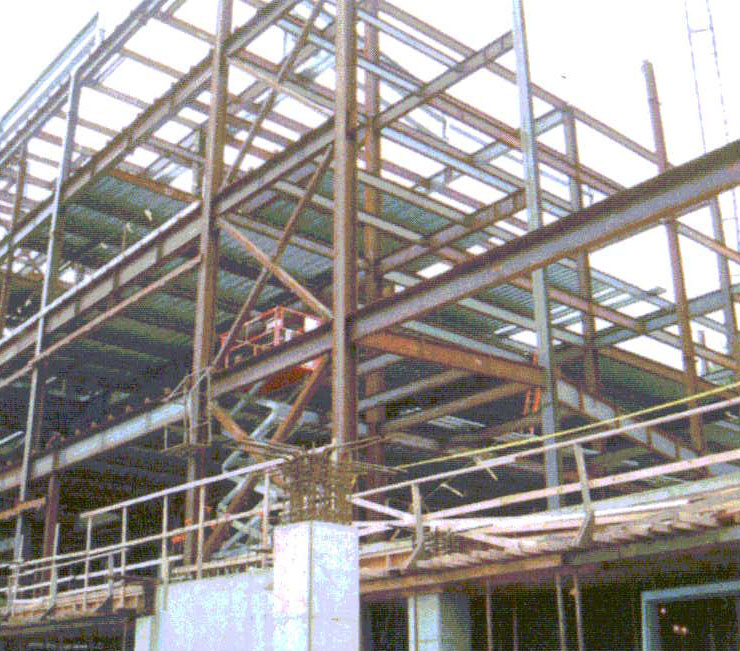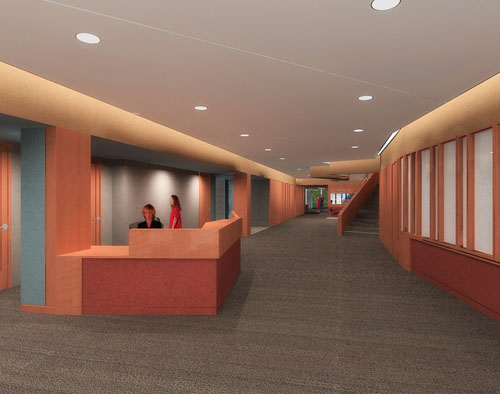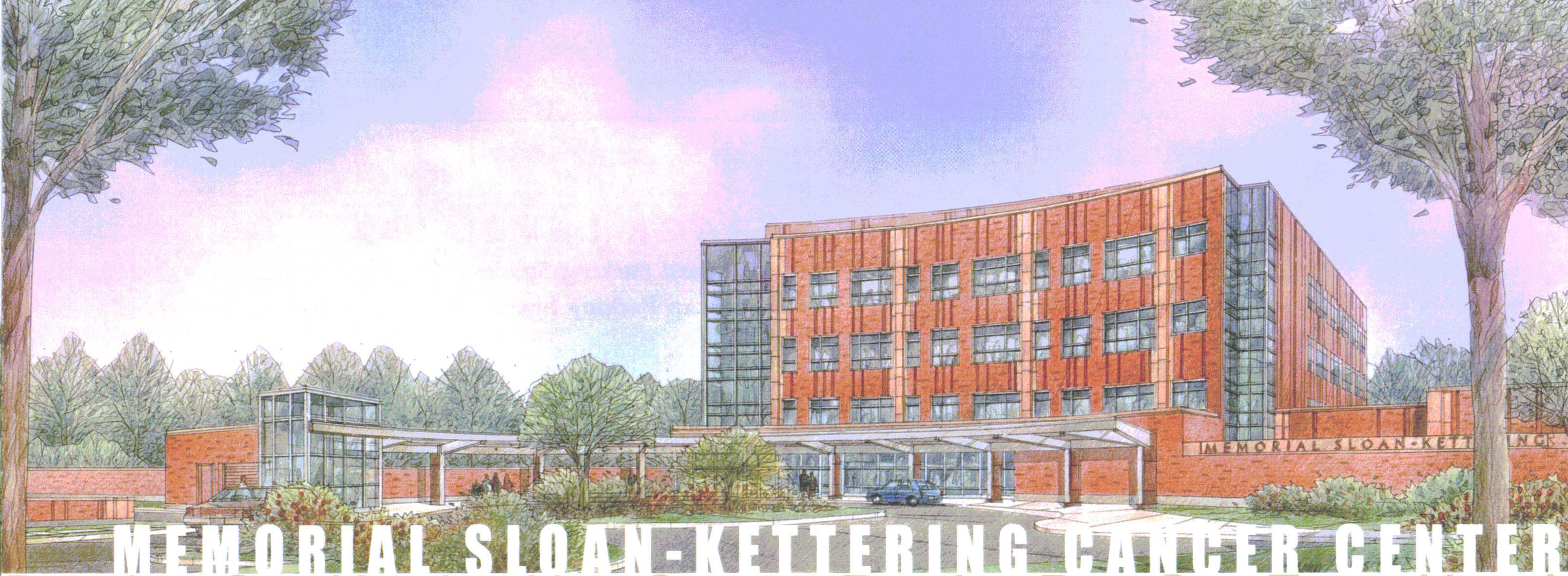Welcome to Jeff Sutterlin's AE Senior Thesis e-Portfolio
Building Statistics
- Building Name: Memorial Sloan-Kettering Cancer Center
- Location and Site: 400 Mountain View Boulevard
Somerset County, New Jersey - Building Occupant Name: Memorial Sloan-Kettering Cancer Center
- Occupancy or Function Types:
- Primary Occupancy: B - Business (Offices; Outpatient Clinics; Ambulatory)
- Accessory Occupancy: S-2 Open-Air Parking Structure
- Size (Total Sq. Ft.): 85,000 Sq. Ft. (Phase 1)
- Number of Stories Above Grade: 4 stories
- Primary Project Team:
- Owner: Sloan-Kettering Institute
Website:
www.ski.mskcc.org
- Architect: Ewing Cole
Website: www.ewingcole.com - MEP Engineers: AKF engineers
Website: www.akf-engineers.com - General Contractor: Barr & Barr Builders
Website: www.barrandbarr.com - Structural Engineers: Ewing Cole
Website: www.ewingcole.com - Dates of Construction (Start-Finish):
- Planned: September 2004 - June 2006
- Actual: September 2004 - June 2006
- Cost:
- Overall Project: $41 million (Phase 1)
- Project Delivery Method: Gross Maximum Price
Building System Information
Architecture: Following Memorial Sloan-Kettering Cancer Centers' tradition of "patient-oriented" cancer care, this facility is designed to create a serene environment for all of its patients. The actual building is strategically located on the north end of the 25-acre wooded lot to maximize patients' interaction with nature as they approach the building. The exterior of MSK articulates soft undulating curves with large windows. The façade's natural face, composed of brick and stone, accents the calming views of the mountain surrounding it. The interior of Memorial Sloan-Kettering creates a warm and reassuring yet sophisticated experience for patients. The exterior curves of the building transform the interior by creating dynamic hallways filled with natural light and breathtaking views of the wilderness around it. Soft tones and textures, natural materials such as wood and stone, a large fish aquarium, and many other interior elements are fine-tuned to focus on the patient. From an architectural standpoint, Memorial Sloan-Kettering Cancer Center creates a soothing and relaxing atmosphere for all its patients. MSKCC prides itself on more then just its aesthetics appeal. The 85,000 square foot facility is the home of two Linear Accelerators for radiotherapy, 23 Chemotherapy Infusion Bays, 27 Office/Consultant Rooms, 38 Exam Rooms, a Lab, and a Pharmacy, all to provide the best cancer care available today. Building Envelope: The building
envelope of Memorial Sloan-Kettering consists of curtain walls supported by
its structural steel framing. The overall façade of MSK is primarily brick
with vertical strips of stone panel offset between windows to give the building
its natural look. Behind the 3-5/8" brick face, a typical curtain wall is
made up mortar barrier mesh, 1 ½" thick rigid insulation, vapor barrier, and
grout-filled, reinforced CMU's, typically 8" thick.
Along with the brick face, Memorial Sloan-Kettering's front façade is full of
large windows. These windows frames span anywhere from 3' to 18' wide and
have a typical height of about 8' on the west elevation, 5'-4" on the other
three sides. The windows are made up of 1" insulated glass with aluminum framing.
The front entrance of MSK is entirely glass, providing an open, welcome feel
to the building. Similarly, the NW and SW corners of the building are incased
entirely in spandrel glass for the top three floors, framing the brick façade
inside and creating a symmetrical look.
Above the front entrance of MSK is a cantilevered canopy, providing shelter to entering patients and divides the glass façade
from the brick. The canopy is made up of steel beams and ties directly into the structural framing of the building.
The roof is made of cast in place concrete slab. Also on the roof is a metal roof screen panel to contribute to the aesthetic
appeal of MSK and hide all HVAC systems from sight.
Construction:
Type 1B - fully-noncombustible, fully sprinklered building
Unlimited floor area and maximum building height of 160 ft.
Memorial Sloan-Kettering Cancer Center will be built in to two-phase operation. Phase One of the building broke ground in
September 2004 and is expected to be completed by June of 2006. The building was initially structurally delivered in packages;
Foundations and Concrete Bid package, and a steel bid package. After all structural packages were assigned, the method of
Gross Maximum Price (GMP) was used for the remainder of the construction period.
Phase Two of Memorial Sloan-Kettering is still in the design stage.
Zoning and Historical:
Business; no historical significance to site.
Major National Codes:
IBC 2000 - NJ Edition National Standard
The building
envelope of Memorial Sloan-Kettering consists of curtain walls supported by
its structural steel framing. The overall façade of MSK is primarily brick
with vertical strips of stone panel offset between windows to give the building
its natural look. Behind the 3-5/8" brick face, a typical curtain wall is
made up mortar barrier mesh, 1 ½" thick rigid insulation, vapor barrier, and
grout-filled, reinforced CMU's, typically 8" thick.
Along with the brick face, Memorial Sloan-Kettering's front façade is full of
large windows. These windows frames span anywhere from 3' to 18' wide and
have a typical height of about 8' on the west elevation, 5'-4" on the other
three sides. The windows are made up of 1" insulated glass with aluminum framing.
The front entrance of MSK is entirely glass, providing an open, welcome feel
to the building. Similarly, the NW and SW corners of the building are incased
entirely in spandrel glass for the top three floors, framing the brick façade
inside and creating a symmetrical look.
Above the front entrance of MSK is a cantilevered canopy, providing shelter to entering patients and divides the glass façade
from the brick. The canopy is made up of steel beams and ties directly into the structural framing of the building.
The roof is made of cast in place concrete slab. Also on the roof is a metal roof screen panel to contribute to the aesthetic
appeal of MSK and hide all HVAC systems from sight.
Construction:
Type 1B - fully-noncombustible, fully sprinklered building
Unlimited floor area and maximum building height of 160 ft.
Memorial Sloan-Kettering Cancer Center will be built in to two-phase operation. Phase One of the building broke ground in
September 2004 and is expected to be completed by June of 2006. The building was initially structurally delivered in packages;
Foundations and Concrete Bid package, and a steel bid package. After all structural packages were assigned, the method of
Gross Maximum Price (GMP) was used for the remainder of the construction period.
Phase Two of Memorial Sloan-Kettering is still in the design stage.
Zoning and Historical:
Business; no historical significance to site.
Major National Codes:
IBC 2000 - NJ Edition National StandardPlumbing Code 2000
National Electric Code 2002
International Mechanical Code 2000 Structural:
 Memorial
Sloan-Kettering Cancer Center's structural system consists of braced structural
steel framing with a concrete foundation. The basement floor of the building
is made up of 6" thick concrete slab on grade. The exterior foundation walls
are 16 inches thick and basement's concrete columns are spaced on a 30'x30'
grid.
The four stories above grade in Memorial Sloan-Kettering consist of structural steel columns, beams, and flanges. The floors
are madu up of 4 1/2 " normal weight concrete slab on galvanized composite metal deck, and are
supported by wide flange beams. A typical floor beam size is a W 16x26, while a typical girder ranges from W 24x68 to
W 24x103. A typical column size is W 24x68. The building's architectural curve was created by bending W18x40 beams about
their weak axis. Structural cross-bracing is provided to resist lateral wind forces.
The roof of Memorial Sloan-Kettering Cancer Center is also cast-in-place concrete slabs, 3 ½" thick and has a maximum unshored
deck span of 8'-2" for a minimum of two continuous spans.
The canopy on the west side of the building is constructed with W24x 68 beams. These beams cantilever out 13'-6" feet from the
building and have a moment resisting connection to the support columns.
The building has its radiotherapy area, called a Linear Accelerator, attached onto its south side. Because this area emits
high levels of radiation, it is necessary for the structure surrounding it to be extremely thick. The Linear Accelerator walls
consist of cast-in-place reinforced concrete and are between 4' and 8' thick. These walls must be placed in one continuous
monolithic pour to ensure no vertical or horizontal joints. Similarly, the roof above the Linear Accelerator is 8' thick, and
is placed in two separate pours.
A 275-car parking garage is attached to the northern side of the cancer center.
Lighting:
Memorial
Sloan-Kettering Cancer Center's structural system consists of braced structural
steel framing with a concrete foundation. The basement floor of the building
is made up of 6" thick concrete slab on grade. The exterior foundation walls
are 16 inches thick and basement's concrete columns are spaced on a 30'x30'
grid.
The four stories above grade in Memorial Sloan-Kettering consist of structural steel columns, beams, and flanges. The floors
are madu up of 4 1/2 " normal weight concrete slab on galvanized composite metal deck, and are
supported by wide flange beams. A typical floor beam size is a W 16x26, while a typical girder ranges from W 24x68 to
W 24x103. A typical column size is W 24x68. The building's architectural curve was created by bending W18x40 beams about
their weak axis. Structural cross-bracing is provided to resist lateral wind forces.
The roof of Memorial Sloan-Kettering Cancer Center is also cast-in-place concrete slabs, 3 ½" thick and has a maximum unshored
deck span of 8'-2" for a minimum of two continuous spans.
The canopy on the west side of the building is constructed with W24x 68 beams. These beams cantilever out 13'-6" feet from the
building and have a moment resisting connection to the support columns.
The building has its radiotherapy area, called a Linear Accelerator, attached onto its south side. Because this area emits
high levels of radiation, it is necessary for the structure surrounding it to be extremely thick. The Linear Accelerator walls
consist of cast-in-place reinforced concrete and are between 4' and 8' thick. These walls must be placed in one continuous
monolithic pour to ensure no vertical or horizontal joints. Similarly, the roof above the Linear Accelerator is 8' thick, and
is placed in two separate pours.
A 275-car parking garage is attached to the northern side of the cancer center.
Lighting:
 The
first floor of MSK primarily uses downlighting to illuminate each area.
All of the corridors throughout the floor are also accented with wall washers.
The exam rooms on the first floor predominately use 1'x4' pendant fluorescent
lighting. A skylight is provided on the south end of the first floor to
bring natural light into the office area. A row of downlights surround the
interior stairwell and the elevator lobby is uses wall washers to give the
area a softer tone.
The
first floor of MSK primarily uses downlighting to illuminate each area.
All of the corridors throughout the floor are also accented with wall washers.
The exam rooms on the first floor predominately use 1'x4' pendant fluorescent
lighting. A skylight is provided on the south end of the first floor to
bring natural light into the office area. A row of downlights surround the
interior stairwell and the elevator lobby is uses wall washers to give the
area a softer tone.
 Jeff
Sutterlin
Jeff
Sutterlin